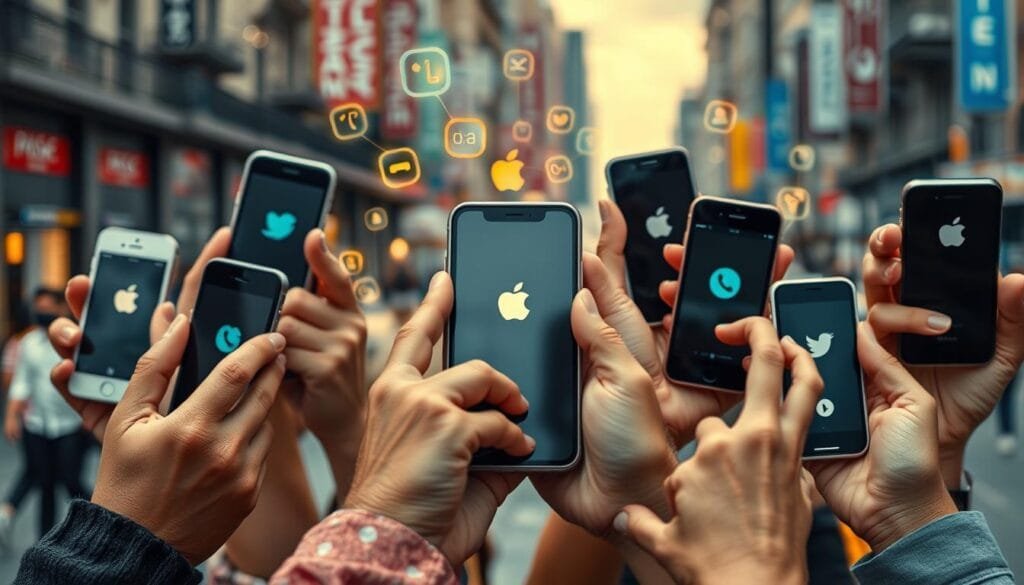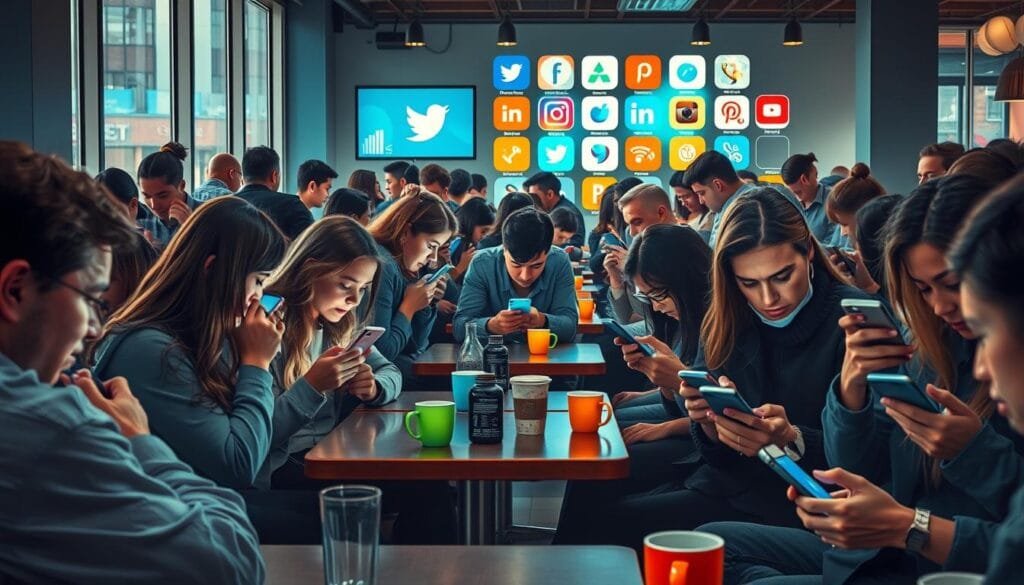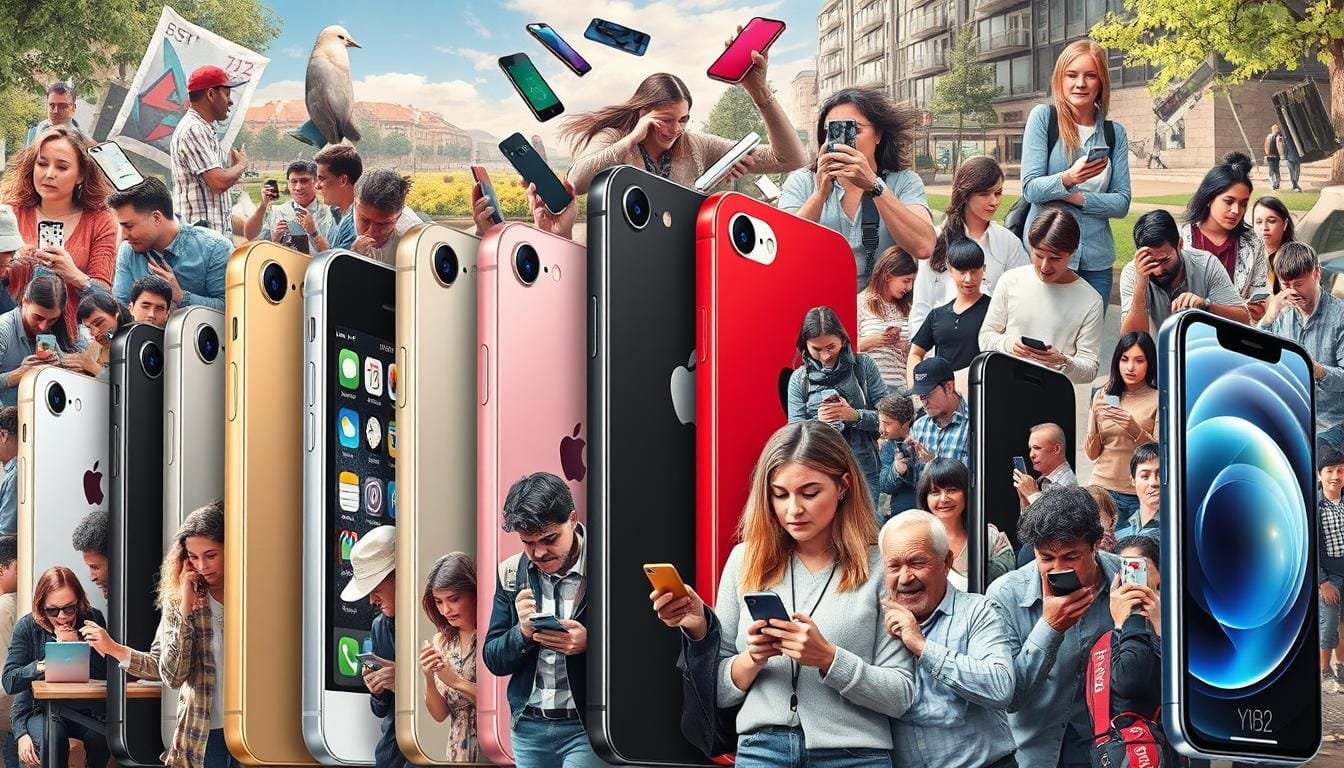In 2007, Apple released the first iPhone, starting a revolution. This launch changed society and technology in many ways. iPhones mix cool design with ease of use. They altered how we talk, connect, enjoy media, and understand the world.
Even after more than ten years, the iPhone’s effects are clear. Apple has sold over 2.3 billion iPhones, and over 1.5 billion users are active now. More than just sales, the iPhone deeply influenced our digital lives.
By the end of 2007, Apple’s iPhone, though behind Nokia in sales, was making waves. It sold 1.4 million units, mostly in the last quarter of that year. By 2011, annual iPhone sales topped 50 million. Apple was selling over 200 million iPhones yearly by 2015, leading the smartphone market.
Apple keeps leading, changing tech trends and how we behave. The iPhone has over 20% of the market but has made Apple a top tech brand. This guide explores how the iPhone changed communication, behavior, and daily life.
Key Takeaways
- The first iPhone was launched in 2007, sparking a tech revolution.
- Apple sold 1.4 million iPhones in 2007, mostly in the last quarter.
- By 2011, sales jumped to over 50 million iPhones a year.
- Apple’s market share is now over 20%, showing its global leadership.
- The iPhone changed digital culture with its design and features.
Introduction to the First iPhone
In January 2007, the first iPhone opened a new chapter in mobile tech. Steve Jobs’ presentation of the iPhone at his keynote set a high bar for future devices. It combined a phone, an iPod, and an internet tool all in one sleek design.
Development and Design
Apple showed its commitment to innovation through careful design of the iPhone. Facing seven big challenges, the company decided to develop the iPhone within its own walls. This kept the project under wraps. They also partnered with key suppliers to ensure they had everything they needed.
This first iPhone had a 3.5-inch screen and a 2-megapixel camera. It was groundbreaking with its touch interface. In 2007, it hit the stores in 4GB and 8GB models. They were priced at $499 and $599, starting a whole new era.
Public Reception and Launch
The iPhone’s launch was well-planned. Apple used innovative marketing to reach different areas gradually. Initially, it was only in the US with Cingular. Then, it reached Europe and Asia in 2007 and 2008. The iPhone quickly won over those unsure about its success.
The first iPhone set the stage for more models like the iPhone 3G. This model saw amazing sales, with one million units sold in just three days after its 2008 release. It showed how impactful Steve Jobs’ vision was.
Revolutionizing Communication
Since its launch in 2007, the iPhone has changed the way we talk and interact every day. The introduction of multitouch made it easier to use, setting a new standard for mobile tech. It did more than combine a phone with a music player; it started a huge tech revolution.

Ease of Use
The iPhone’s success comes from its easy-to-understand design and multitouch feature. It made complex tasks simple, from calling to surfing the web. This ease of use led to more people using iPhones and changed how we communicate.
Introducing the App Ecosystem
The iPhone also introduced us to the world of apps, changing how we use our phones. Now, with many apps available, our phones can do so much more, from social media to getting work done. An Emergen Research article mentions how this change has made apps a big part of our lives.
Here’s how the iPhone and its apps have changed things:
| Impact Area | Details | Year |
|---|---|---|
| Photography | 85% of 400 billion digital photos taken on phones | 2011 |
| App Store Revenue | $10.5 billion from downloads and in-app purchases | Q1 2017 |
| On-demand Jobs | Expected to double to 8 million workers | Next 4 years |
The iPhone has truly changed communication and become a vital part of our lives. It has altered how we see and interact with the world.
How the First iPhone Shifted Technological Trends
When the first iPhone debuted in 2007, it changed mobile technology drastically. It influenced smartphone technology, shaping both hardware and *iPhone software*. Let’s look at how it changed these areas.
Hardware Innovations
Apple’s dedication to innovative iPhone hardware has reshaped smartphone tech. The iPhone 4’s Retina Display brought unmatched screen clarity. Then, the iPhone 5S introduced Touch ID, changing device security with fingerprint scanning.
The iPhone X made a leap with Face ID, using facial recognition for better security and ease. The trend continued with iPhone 12 models, which offered quicker download speeds through 5G. The iPhone 15 series raised the bar with powerful A17 Pro chips, superior cameras, and features like Dynamic Island and Always-On Display.
| iPhone Model | Key Hardware Feature | Release Year |
|---|---|---|
| iPhone 4 | Retina Display | 2010 |
| iPhone 5S | Touch ID | 2013 |
| iPhone X | Face ID | 2017 |
| iPhone 12 | 5G Support | 2020 |
| iPhone 15 | A17 Pro Chip & Dynamic Island | 2023 |
Software Improvements
The growth of iPhone software has been just as impactful, securing its place as a tech leader. The App Store, launched in 2008, made a huge marketplace for developers and users alike. By January 2018, developers had made $120 billion from the App Store, highlighting its massive success.
Apple has continued to update its software regularly, keeping even older devices safe and functional. With up to 6 years of software support, iPhones last longer than most other phones. They also have advanced privacy and security built into their software.
Software advances like machine learning and augmented reality have opened new possibilities. These include pro-level photography features like Night Mode and AR experiences. This has significantly elevated user experience.
To sum up, the first iPhone started a wave of breakthroughs across the smartphone industry. By improving both hardware and software, Apple has continually set new standards for innovation. Its impact on technology is undeniable.
What Impact Did the First iPhone Have on Society?
The iPhone’s debut in 2007 was a turning point in tech history. Before it, mobile phones were mainly for calls and texts. The iPhone merged various functions into one, starting a new smartphone era. Apple’s focus on quality made the iPhone in less than three years, using the iPod’s success to change mobile tech.
The original iPhone made waves immediately. It sold 270,000 units in the first 30 hours, showing huge consumer interest. Steve Jobs aimed for a device that was easy to use and had great call quality. This focus on the user experience led to major changes in tech lifestyles, making smartphones essential.

The iPhone also changed how other phones were made. For example, the 2011 Samsung Galaxy Note brought in big screens. But, Apple kept to its design principles until the iPhone 6 Plus. Below are pictures showing how screen designs evolved:
| Model | Release Year | Screen Size | Key Features |
|---|---|---|---|
| iPhone (Original) | 2007 | 3.5 inches | 2MP Camera, Reduced Calls, No App Store |
| iPhone 4S | 2011 | 3.5 inches | 8MP Camera, Siri Assistant |
| iPhone 6 Plus | 2014 | 5.5 inches | Thinner Design, Enhanced Screen Size |
| iPhone 7 | 2016 | 4.7 inches | Removed Headphone Jack, Introduced AirPods |
| iPhone X | 2017 | 5.8 inches | Facial Recognition, No Home Button |
The iPhone’s impact wasn’t just in hardware. The App Store, launched in 2008, saw over 100 million app downloads in two months. By January 2010, downloads hit three billion. The iPhone thus shaped how we use apps for work, socializing, and fun, changing our daily interaction with technology.
The iPhone’s Role in Human Behavior and Daily Life
The iPhone has changed how we live our everyday lives. It has altered the way we consume media, connect on social platforms, and make digital content. These changes are worth a closer look.
Consumption of Media
The arrival of the iPhone has taken media consumption to new levels. We can now easily stream videos, read the latest news, or enjoy music all in one place. In 2017, people took almost 1.2 trillion digital photos worldwide. A staggering 85% of these were snapped using phones. This highlights the iPhone’s big role in how we consume and interact with digital media today.
Social Interactions
iPhones have dramatically transformed social media use. They’ve turned social networks into essential parts of our daily lives. Started with just 500 apps, the iPhone now offers over 2.1 million. This is more than Google Play. It has made staying in touch and sharing moments easier than ever.

Photography and Content Creation
The iPhone has revolutionized mobile photography and content creation. Its advanced camera tech allows anyone to take amazing photos and videos. Apple keeps improving its cameras. This ensures users always have the best tools for digital creativity at their fingertips.
| Aspect | iPhone Impact | Data |
|---|---|---|
| Media Consumption | Central Hub | 1.2 trillion digital photos in 2017 |
| Social Media | Integral to Daily Life | 2.1 million apps on App Store |
| Photography | High-Quality Creation | 85% of photos taken on phones |
The iPhone has had a big impact on how we use media, interact socially, and create content. Its influence continues to shape our daily lives. As technology progresses, we can only expect these effects to expand and deepen.
Conclusion
The first iPhone in 2007 changed how we think about technology and phones. Even though it missed some features we love today, it still made a big splash. With a price tag between $499 to $599 and tied to AT&T, people were eager to buy it, even waiting in lines for days.
When you adjust for inflation, the first iPhone would cost about $687 now. It didn’t have an App Store or changeable wallpapers. Yet, it redefined mobile phones with its 2-megapixel camera and Edge network connection.
Since its debut, the iPhone has transformed. It has changed how we act, communicate, and connect with the world. More than just a phone, it has impacted our lives in countless ways. This journey shows the iPhone’s significant role in advancing technology and marking its spot in history.
FAQ
What was the impact of the first iPhone on society?
The first iPhone changed how we talk, meet, and use technology. It made smartphones a big part of our lives.
How did the development and design of the first iPhone come about?
Steve Jobs and Apple made the iPhone simple and easy to use. They focused on making it look good and work well.
What was the public reception when the iPhone first launched?
People loved the iPhone from the start. Its new features and design were a hit. The launch was a big event, thanks to Steve Jobs.
How did the first iPhone revolutionize communication?
The iPhone made talking, texting, and browsing easy. Its touchscreen and apps did everything. This changed how we communicate.
What role did the app ecosystem play in the iPhone’s success?
The App Store was a game-changer. It let developers make new apps that made the iPhone even better. It started the app economy.
What hardware innovations did the first iPhone bring to the market?
The iPhone had a new touchscreen and better parts like processors and sensors. This raised the bar for smartphones.
What were some of the software improvements introduced with the first iPhone?
The iPhone’s system was made for easy use. It had things like swipe gestures, a web browser, and visual voicemail. These made it nice to use.
How did the iPhone shape societal trends and influence human behavior?
The iPhone made us always connected. It changed how we use media, social networks, and share our lives with pictures and videos.
What impact did the first iPhone have on media consumption?
With the iPhone, we could get media like music and news anytime, anywhere. It led to a culture where we expect media on demand.
How did the iPhone change social interactions?
The iPhone made talking and sharing with people faster and easier. It brought the world closer, changing how we interact.
What advancements did the first iPhone bring to photography and content creation?
The iPhone let everyone make and share great photos and videos. Its camera and apps opened up new ways to be creative.
